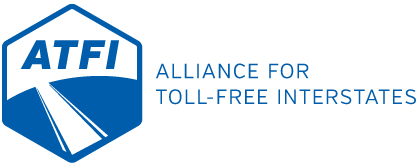In 1998, North Carolina, Missouri and Virginia were all given a unique opportunity to roll the dice under the federal Interstate System Reconstruction and Rehabilitation Pilot Program (ISRRPP) and put tolls on one existing interstate in their states to raise funds for repairing interstate corridors.
The result so far? Snake eyes, which is no surprise to Hayes Framme, a spokesman with the Alliance for Toll-Free Interstates (ATFI).
“The three states that are allowed to do it have not done it,” Framme said. “We’ve seen this conversation start to bubble up. Some have floated the ideas of tolls, but others are seeing the challenges of tolls.”
ATFI, made up of individuals, businesses and organizations, aims to educate the general public, lawmakers and media outlets on the negative impacts of tolling, according to its website, tollfreeinterstates.com.
In 1956, the federal government decided against tolling interstates, but rather funding transportation through a federal fuel tax. As the Highway Trust Fund continues to shrink, Congress is scrambling for new ways for states to fund transportation projects. This is one of the factors that led to the pilot program ISRRPP, which allowed Missouri, North Carolina and Virginia to test tolls on a stretch of interstate.
Framme pointed to Virginia’s transportation bill passed in February 2013 that repealed the gas tax and put in place a 3.5 percent wholesale gas tax. It also forbids tolling on I-95.
“We all along did not oppose the idea that Virginia needs more money for transportation to fix our roads,” said Dale Bennett, president of the Virginia Truckers Association.“We objected to pushing for tolls to do so. A fuel tax is much more effective in doing so from a dollars and cents perspective.”
Bennett explained that for every $1 in taxes paid at the pump, about “97 cents of that dollar goes directly toward pavement,” i.e., fixing the roadways.
“In tolls, they’d be lucky if 65 to 75 cents was used to put down pavement,” Bennett said, citing the operating costs of toll systems.
According to a document that mapped out the Virginia Trucking Association’s opposition to the I-95 tolling project, it stated: “Under VDOT’s Toll Plan, 38 percent of the toll revenue collected will be spent to pay for the capital, operating and maintenance cost of the toll collection system.During the first 25 years of toll collection, nearly 16 percent of the total revenue will be diverted to pay for collecting the tolls.In comparison, less than 1 percent of the revenue collected from Virginia’s fuel tax is spent to collect it.”
For the trucking side, the letter continued: “Trucking already pays 35 percent of the federal and state highway user fees collected for Virginia, but accounts for only 8 percent of total miles traveled in the state. Based on what we have seen, the governor’s proposal would impose as much as a $22.9 million dollar tax increase on the trucking industry.”
The tolling, which would have taken place from Fredericksburg to the North Carolina border, was met with little support, particularly from trucking interests.
“It had very little support. A number of people were concerned about the horrible impacts it would have,” including not being able to attract new businesses and give additional costs to low-income families who used the interstate, Bennett said.
For Framme and fellow ATFI members, the push to potentially use tolls on existing interstates is heading down a path that would ultimately produce more problems than positive funding results, including:
Traffic diversion
In order to avoid shelling out money to travel down an interstate, Framme said many people may decide to take the back roads, particularly locals traveling to work and school and truckers with local companies.
“One, that creates delays for the shipping of goods because they have to slow down,” taking a back road, Framme said. “It deteriorates those secondary roads quickly. They’re not meant to handle heavy traffic.”
High administrative costs
“Up to a third of the revenue generated from tolling facilities went to the cost of enforcing scofflaws” to pay the tolls, Framme said.
Economic development
For trucking companies already built in an area, a new toll would increase the cost of shipping, which means a certain percentage would ultimately be passed down to the customers, Framme said.
New businesses may not be willing to locate certain facilities by a toll road, Framme said. “In the same vein, businesses that currently exist could suffer and potentially move.”
Double taxation
Alliance members are adamant that tolling on existing interstates would lead to double taxation.
“On existing non-tolled interstates, you’re talking about people having to pay at the pump … plus paying a toll on those roads they’ve already paid for once,” Framme said. “That’s the double taxation argument.”
For too long, Bennett said politicians have tried to convince people that tolling is easier than raising a gas tax.
“Obviously, the anti-tax sentiment that people express, that probably has a lot to do with it in the states and in Washington, what’s happening to our interstate system … No one will argue we need more money. No one there has an appetite to raise taxes. Nothing is getting done because of the political backlash,” Bennett said. “Truck drivers need to be aware because there are well-financed sources out there pushing to provide tolling as a way to fix the roads.”
The best way to combat tolling, Bennett said, starts with the truckers who work out on the roadways.
“Word of mouth is a wonderful thing.Truckers don’t live in a vacuum … reach out and talk to the people you know, the community, family,” Bennett said. “Look, there are politicians out there that would rather toll your roads and waste your money.”
Framme also suggested reaching out to state and federal representatives and talking with alliance members.
“Stay involved, get involved, be active at this point because the fight is only going to get more intense as time goes on,” Framme said.

